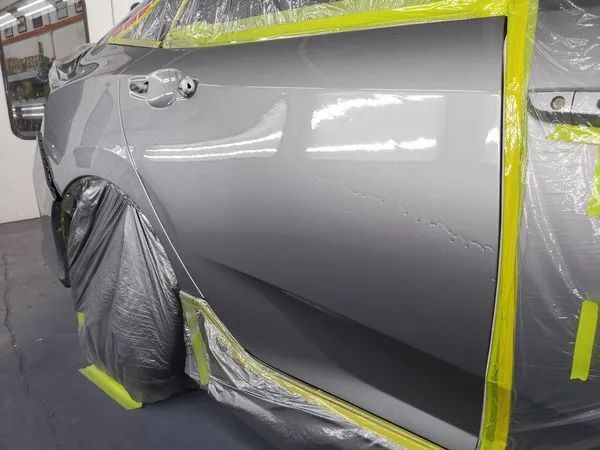Sagging (also known as Running) refers to uneven paint defects that occur during automotive spraying when the coating is applied too thick or unevenly. Under the influence of gravity, the paint flows downward, forming streaks, drips, or tear-like shapes. Sagging not only affects the appearance but also causes uneven coating thickness, compromising the performance and durability of the paint film.

Visual Appearance:
Noticeable streaks, runs, or flow marks on the paint surface, often appearing as downward trails of excess paint.
Surface Texture:
The surface feels uneven with localized areas of paint buildup.
Typical Occurrence:
Sagging usually appears on vertical or inclined surfaces where gravity causes the paint to slide down.
Excessive Coating Thickness
Applying too much paint at once prevents even drying, causing the coating to run.
Spraying Distance Too Close
Holding the spray gun too close to the surface concentrates paint in a small area, leading to over-thick coating.
Slow Spraying Speed
Moving the spray gun too slowly results in paint accumulation in certain areas, increasing sagging risk.
Over-Diluted Paint
Incorrect thinner ratio makes the paint too fluid, enhancing its flow and increasing the likelihood of sagging.
Unfavorable Spraying Environment
Low temperatures, poor ventilation, or high solvent vapor concentration slow drying, making the paint surface too wet and prone to sagging.
Incorrect Spray Gun Settings
Using an oversized nozzle with low air pressure or a narrow spray pattern causes excessive paint output, leading to sagging.
Improper Surface Preparation
Incomplete degreasing or poor cleaning prevents proper paint adhesion, increasing the risk of sagging, especially on contaminated or glossy old coatings. Proper sanding and cleaning are essential.
Control Coating Thickness
Apply thin and even coats. Avoid applying overly thick layers in one pass.
Maintain Proper Spraying Distance
Keep the spray gun 15-20 cm away from the surface for even paint distribution.
Adjust Spraying Speed
Move the spray gun at a steady, moderate speed. Avoid pausing or slowing down over any area.
Optimize Paint Formulation
Dilute the paint strictly according to the manufacturer's recommendations to ensure proper viscosity and flow.
Control Spraying Environment
Spray under recommended conditions, ideally at temperatures between 20-25°C and with good ventilation.
Correct Spray Gun Setup
Regularly calibrate your spray gun. Ensure the nozzle size, air cap, and air pressure match the type of paint being used.

Sanding and Polishing:
For minor sagging, sand the affected area with fine-grit sandpaper (1500-2000 grit) and polish the surface to restore smoothness and gloss.
Local Repainting:
For more severe sagging, sand the affected area thoroughly and reapply paint for localized repair.
By following proper spraying techniques, controlling environmental factors, and using the correct equipment and paint formulations, sagging or running can be effectively prevented, ensuring a smooth, high-quality automotive finish.